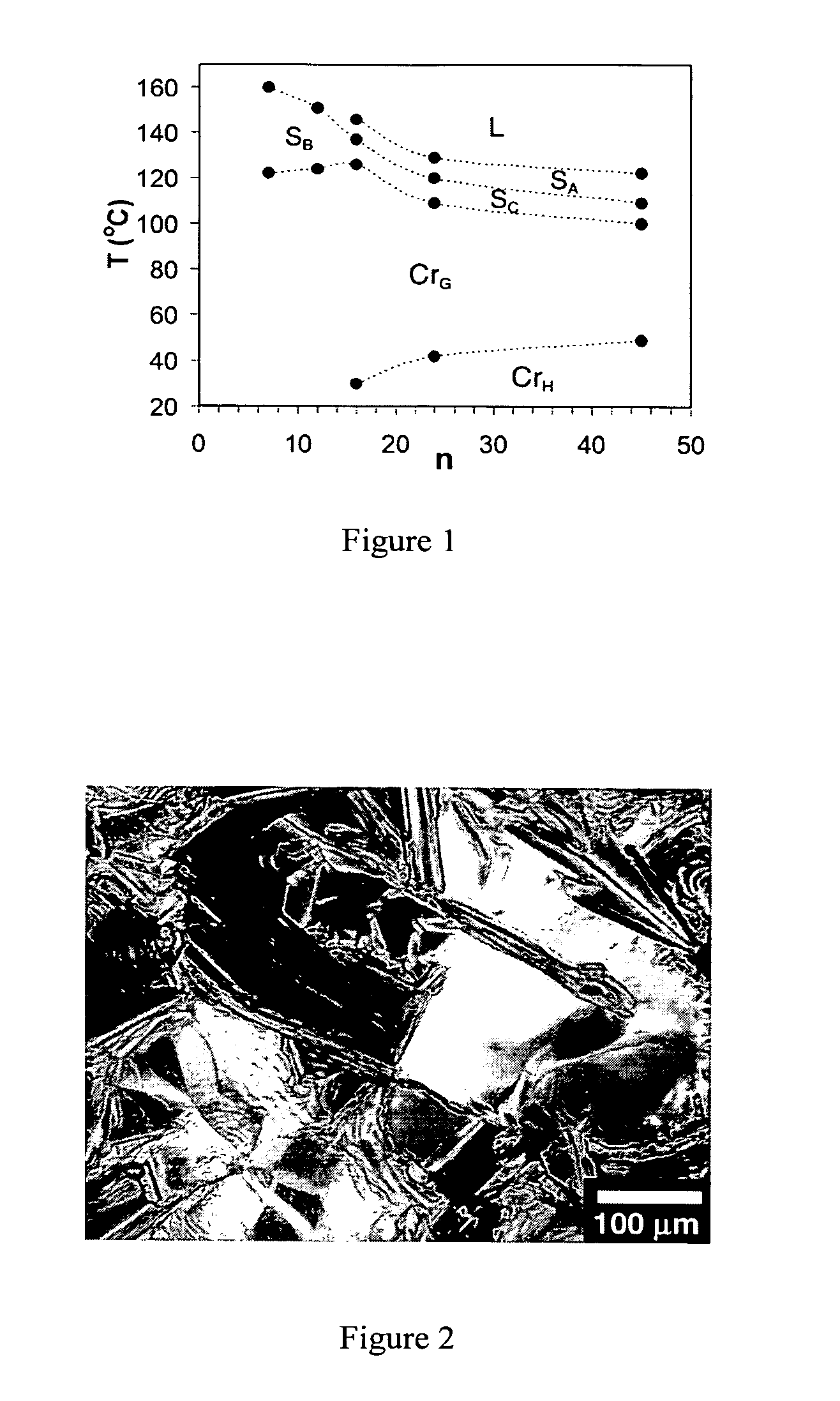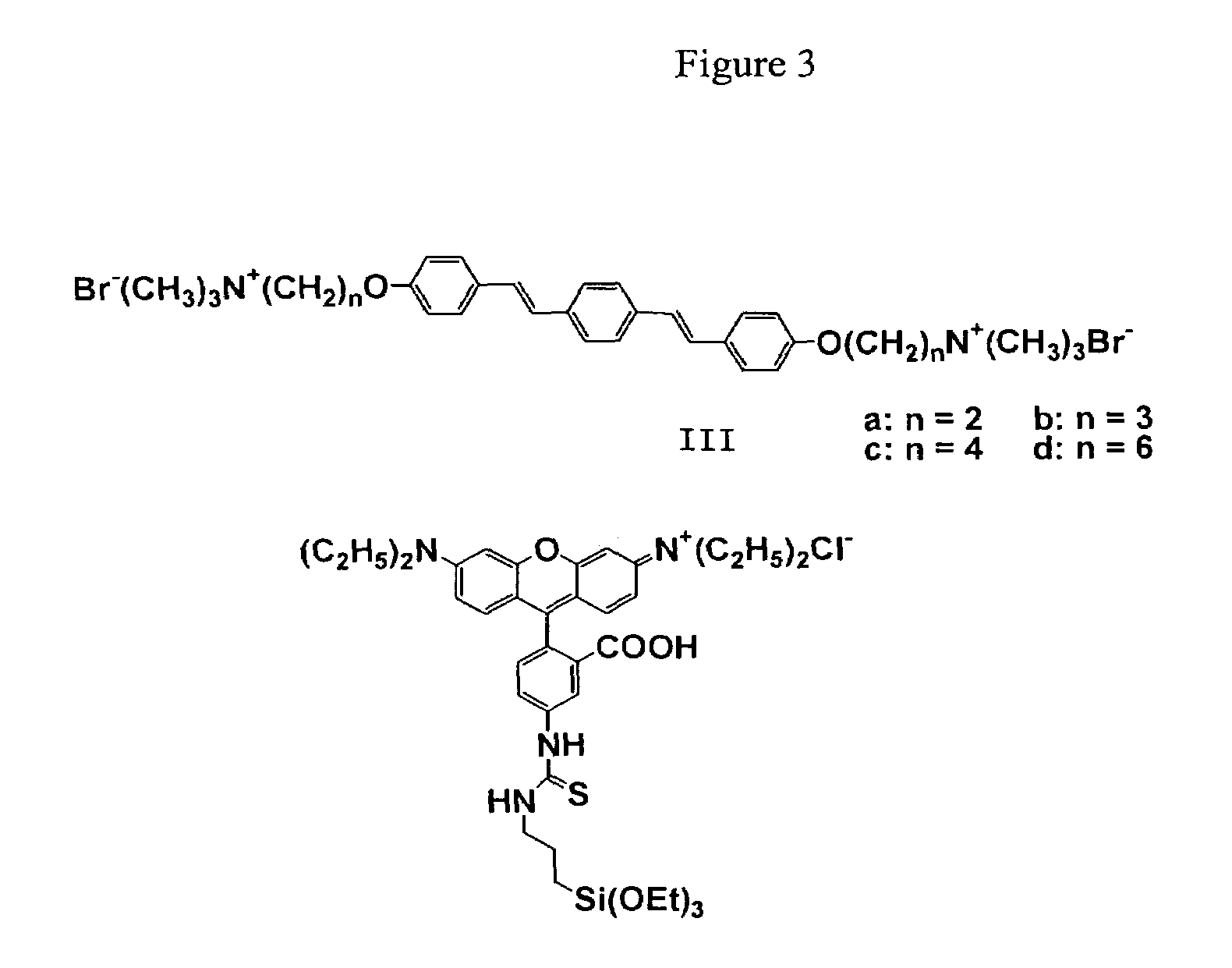Oligo(p-phenylene vinylene) amphiphiles and methods for self-assembly
a technology of oligos and amphiphiles, applied in the preparation of carbonyl compounds, organic chemistry, group 5/15 element organic compounds, etc., can solve the problems of affecting the co-existence of the two, affecting the stability of the compound,
- Summary
- Abstract
- Description
- Claims
- Application Information
AI Technical Summary
Benefits of technology
Problems solved by technology
Method used
Image
Examples
example 1
[0024]The OPV-8 amphiphile, illustrating an embodiment of compound II, was synthesized by the following procedures (1a-1g). Other OPV-n amphiphiles were synthesized by a similar procedure beginning with longer poly(ethylene glycol)methyl ethers. Unless otherwise noted, all starting materials were obtained from commercial suppliers and used without further purification. 4-(Dimethylamino)-pyridinium-4-toluenesulfonate (DPTS) was prepared according to literature. (Granier, T.; Thomas, E. L.; Gagnon, D. R.; Karasz, F. E.; Lenz, R. W. J. Polym. Sci. Part B: Polym. Phys. 1986, 24, 2793-2804.) The 1H NMR and 13C NMR spectra were recorded on a Varian Unity 400 (400 MHz) or Unity 500 (500 MHz) spectrometer using the solvent proton signal as standard. Mass spectra were obtained on a Micromass Quattro II atmospheric pressure ionization (API) triple quadrupole mass spectrometer. Matrix-assisted laser desorption ionization-time of flight mass spectrometry (MALDI-TOF MS) was performed on an Appli...
example 1a
[0025]Poly(ethylene glycol)methyl ether-4-bromomethyl benzoate (1). α-Bromo-p-toluic acid (1.07 g, 5.00 mmol, 1.00 equiv.), poly(ethylene glycol) methyl ether (Mw=350 g / mol, 1.75 g, 5.00 mmol, 1.00 equiv.), DPTS (1.56 g, 5.30 mmol, 1.06 equiv.), and CH2Cl2 (150 ml) were all combined in a flask with a stirring bar. 1-(3-(Dimethylamino)propyl)-3-ethylcarbodiimide hydrochloride (1.44 g, 7.53 mmol, 1.50 equiv.) was added and the reaction mixture was stirred for 24 h at room temperature. The solution was washed with 5% aqueous solution of citric acid, and saturated aqueous solution of NaCl. The organic layer was collected, dried with MgSO4, filtered, and concentrated in vacuo. The product was subjected to a column chromatography using 5% MeOH / CH2Cl2 as the eluant to afford the product (2.2 g, 4.0 mmol, 80% yield).
[0026]1H NMR (400 MHz, CDCl3) δ: 8.06 (d, 2H, J=7.9 Hz), 7.47 (d, 2H, J=8.6 Hz), 4.63 (s, 2H), 4.50 (t, 2H, J=4.9 Hz), 3.85 (t, 2H, J=4.6 Hz), 3.67 (m, 24H), 3.39 (s, 3H); 13C N...
example 1b
[0027]Poly(ethylene glycol)methyl ether-4-((diethylphosphono)methyl) benzoate (2). Benzyl bromide 1 (1.0 g, 2.1 mmol, 1.0 equiv.) and triethyl phosphite (0.72 mL, 4.2 mmol, 2.0 equiv.) were placed in a flask with a magnetic stirring bar. A distillation apparatus was attached to collect ethyl bromide formed along with the reaction. The mixture was immersed in an oil bath and heated to 130° C. for 24 h. The reaction mixture was cooled, diluted with Et2O, and washed with H2O. The organic layer was dried with MgSO4, filtered, and concentrated in vacuo. The resulting oil (1.29 g, 2.10 mmol, 100% yield) was used for the next Horner-Emmons reaction without further purification. 1H NMR (400 MHz, CDCl3) δ: 8.00 (d, 2H, J=7.9 Hz), 7.37 (d, 2H, J=7.3 Hz), 4.45 (t, 2H, J=4.9 Hz), 4.01 (t, 2H, J=6.7 Hz), 3.63 (m, 24H), 3.19 (d, 2H, J=22.0 Hz).
PUM
| Property | Measurement | Unit |
|---|---|---|
| domain sizes | aaaaa | aaaaa |
| length | aaaaa | aaaaa |
| length | aaaaa | aaaaa |
Abstract
Description
Claims
Application Information
 Login to View More
Login to View More - R&D
- Intellectual Property
- Life Sciences
- Materials
- Tech Scout
- Unparalleled Data Quality
- Higher Quality Content
- 60% Fewer Hallucinations
Browse by: Latest US Patents, China's latest patents, Technical Efficacy Thesaurus, Application Domain, Technology Topic, Popular Technical Reports.
© 2025 PatSnap. All rights reserved.Legal|Privacy policy|Modern Slavery Act Transparency Statement|Sitemap|About US| Contact US: help@patsnap.com



